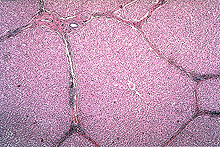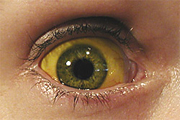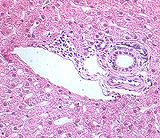 Liver
-- is responsible for many different functions and is unusual in
being supplied by both arterial blood (for oxygen) and venous blood
(with nutrients for processing). Liver
-- is responsible for many different functions and is unusual in
being supplied by both arterial blood (for oxygen) and venous blood
(with nutrients for processing).
Review the structural organization of
the liver parenchyma, noting inflow of blood to
lobules from branches of both the hepatic artery and hepatic portal
vein and outflow through central venules to branches of the hepatic
vein. Note also how bile originates within lobules and is drained
via branches of the bile duct. A simplified version of one liver
lobule in transverse section is shown in the diagram on the next
page.
 List
several unrelated functions of hepatocytes. List
several unrelated functions of hepatocytes.
Clinical note: Hepatitis
involves infection or inflammation of hepatocytes and other
epithelial components in the liver. Cirrhosis involves excessive
proliferation of fibroblasts and collagen deposition in the stroma
of the liver. Hepatocytes have a remarkable capacity for
regeneration, but chronic, long-term alcoholism leads to the death
of these cells and cirrhosis.
 Examine
a section of the liver and with the low
power objective, locate a set of portal tracts outlining a lobule. With the higher power objectives, identify the
central venule
in the center of the lobuleand the "triad" of
components in a portal tract, namely branches of the hepatic portal
vein, hepatic artery, and bile duct. Examine
a section of the liver and with the low
power objective, locate a set of portal tracts outlining a lobule. With the higher power objectives, identify the
central venule
in the center of the lobuleand the "triad" of
components in a portal tract, namely branches of the hepatic portal
vein, hepatic artery, and bile duct.
How does the organization of
hepatocytes as plates facilitate their functioning?
Where is most of the connective tissue of the liver located?
Detail of the
hepatic lobule. |